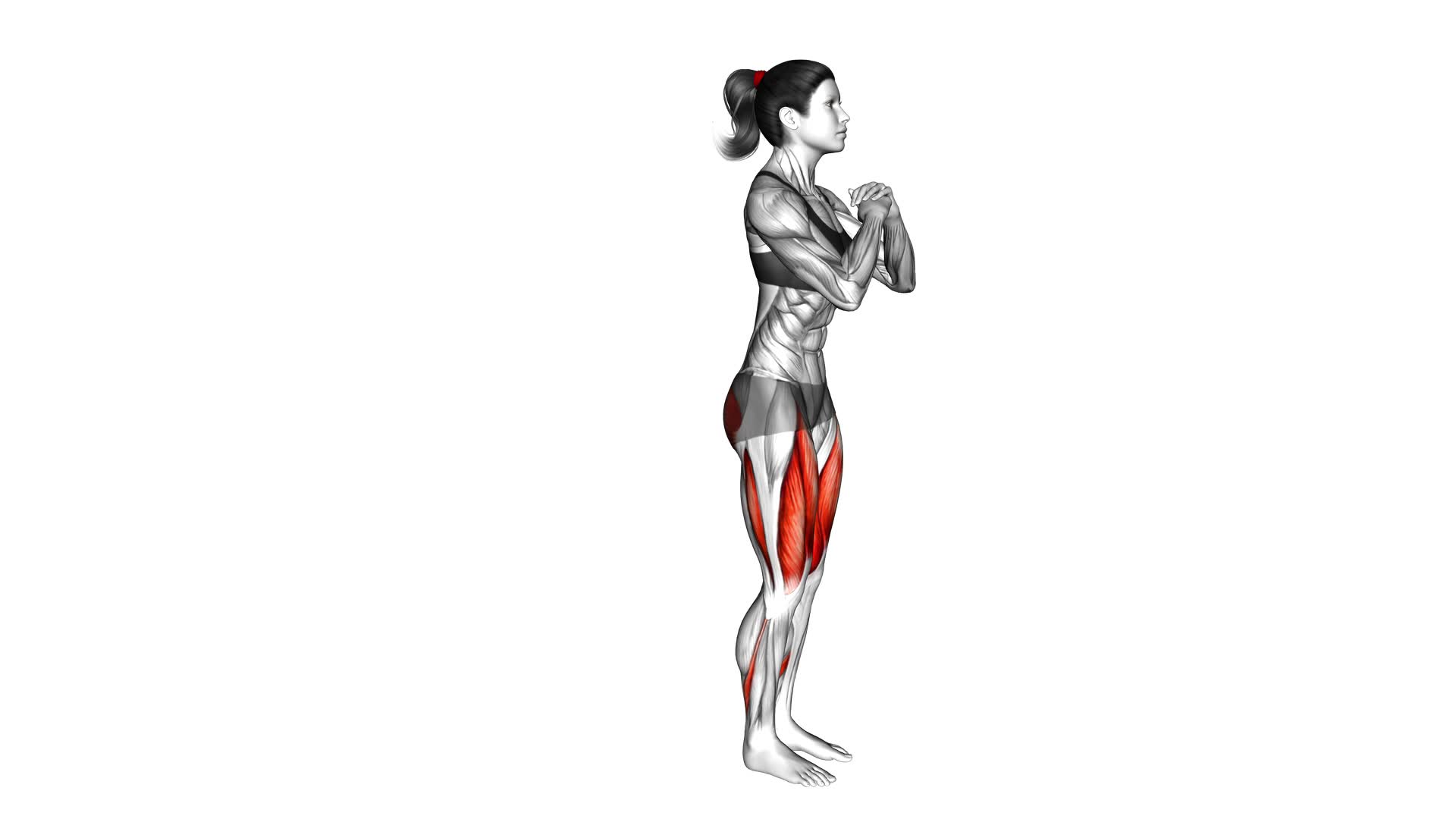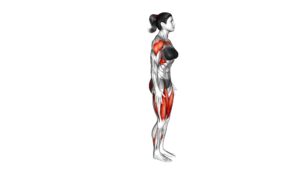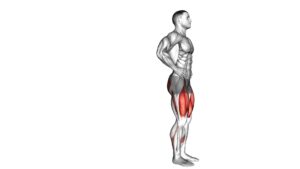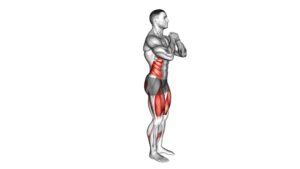Bodyweight Rear Lunge (female) – Video Exercise Guide & Tips

Are you looking for an effective lower body exercise that can be done anywhere? Look no further than the bodyweight rear lunge.
Watch This Exercise Video
This exercise targets your glutes, quads, and hamstrings, helping you build strength and tone your legs.
In this video exercise guide, we'll show you the proper form and technique specifically for females. Plus, we'll share common mistakes to avoid, variations to challenge yourself, and tips for incorporating the bodyweight rear lunge into your routine.
Let's get started!
Key Takeaways
- The bodyweight rear lunge targets the glutes, quads, and hamstrings.
- It builds strength and tones the legs.
- The exercise activates multiple muscle groups and improves flexibility and hip mobility.
- Incorporating the bodyweight rear lunge into a routine can lead to improved athletic performance and reduced risk of injury.
Benefits of the Bodyweight Rear Lunge
You will experience several benefits when incorporating the bodyweight rear lunge into your exercise routine. This exercise is an excellent way to activate and strengthen your muscles while also improving flexibility.
One of the main benefits of the bodyweight rear lunge is its ability to activate multiple muscle groups. As you perform the lunge, you engage your quadriceps, hamstrings, glutes, and calves. This activation helps to build strength and tone these muscles, resulting in improved overall lower body strength.
In addition to muscle activation, the bodyweight rear lunge also contributes to flexibility improvement. The lunge requires you to step back and lower your body, which stretches your hip flexors and increases hip mobility. This can be particularly beneficial if you spend a lot of time sitting or have tight hip muscles.
By incorporating the bodyweight rear lunge into your routine, you can achieve a variety of benefits, including increased muscle activation and improved flexibility. These benefits can then translate into improved athletic performance and reduced risk of injury.
Now, let's move on to discussing the proper form and technique for females.
Proper Form and Technique for Females
To perform the bodyweight rear lunge correctly, females should focus on maintaining proper form and technique. This exercise is a great addition to any female fitness routine, as it specifically targets the lower body muscles and helps build lower body strength.
When performing the bodyweight rear lunge, start by standing with your feet hip-width apart. Take a step back with your right foot, landing on the ball of your foot. Bend both knees to lower your body towards the ground, making sure to keep your front knee aligned with your ankle. As you lower, engage your core and keep your chest lifted.
Push through your front heel to return to the starting position, and repeat the movement on the other side. Keep your movements controlled and avoid rushing through the exercise.
Maintaining proper form and technique is crucial for maximizing the benefits of the bodyweight rear lunge. By focusing on engaging the correct muscles and keeping your body aligned, you can effectively strengthen your lower body and improve your overall fitness. Remember to always listen to your body and modify the exercise if needed.
Common Mistakes to Avoid
To ensure proper form and technique while performing the bodyweight rear lunge, it's important to be aware of common mistakes that should be avoided. By understanding these mistakes, you can make adjustments to your technique and improve your overall performance.
One common mistake to avoid is allowing your front knee to extend beyond your toes during the lunge. This places unnecessary strain on your knee joint and can lead to injury. To correct this, focus on keeping your front knee directly above your ankle throughout the movement. This will ensure that you're engaging the correct muscles and maintaining proper alignment.
Another mistake to watch out for is leaning too far forward during the lunge. This can cause strain on your lower back and compromise your balance. Instead, keep your torso upright and engage your core muscles to maintain stability. This will help you to effectively target your leg muscles and avoid unnecessary stress on your back.
Lastly, avoid rushing through the movement. Performing the bodyweight rear lunge too quickly can compromise your form and decrease the effectiveness of the exercise. Take your time and focus on maintaining control throughout the entire range of motion. This will allow you to fully engage your muscles and maximize the benefits of the exercise.
Variations to Challenge Yourself
For a greater challenge, try incorporating different variations into your bodyweight rear lunge routine. These advanced modifications won't only target your leg muscles more effectively but also engage your core and improve your balance.
One option is to add weight to your lunges. You can hold dumbbells in each hand or wear a weighted vest to increase the resistance. This will intensify the workout and help you build strength and endurance.
Another variation is to perform the lunge on an unstable surface, such as a balance board or a BOSU ball. This will require you to engage your stabilizer muscles and improve your overall balance and coordination.
If you're looking for a low-impact option, you can try the reverse lunge on a step or a bench. This will increase the range of motion and challenge your muscles in a different way.
Remember to always choose modifications that align with your fitness level and listen to your body.
Now that you know some advanced variations, let's move on to the next section for tips on incorporating the bodyweight rear lunge into your routine.
Tips for Incorporating the Bodyweight Rear Lunge Into Your Routine
To effectively incorporate the bodyweight rear lunge into your routine, focus on maintaining proper form and gradually increasing the difficulty level. This exercise is great for targeting your glutes, hamstrings, and quadriceps while also improving balance and stability. If you're a beginner, there are a few modifications you can make to make the bodyweight rear lunge more accessible.
First, start by performing the exercise without any weights. This will help you get comfortable with the movement and ensure you have proper form. You can also start by performing the exercise with a shorter range of motion, taking smaller steps back until you build up strength and flexibility. As you become more comfortable, you can gradually increase the difficulty by holding dumbbells or adding resistance bands.
To incorporate the bodyweight rear lunge into a full-body workout, you can include it as part of a circuit or superset. For example, you can perform a set of bodyweight rear lunges followed by push-ups or planks. This will help you engage multiple muscle groups and keep your heart rate up. You can also combine the bodyweight rear lunge with other lower body exercises, such as squats or step-ups, to create a comprehensive lower body workout.
Remember to always listen to your body and adjust the intensity and difficulty level as needed. By incorporating the bodyweight rear lunge into your routine, you'll be on your way to building strength, improving balance, and achieving your fitness goals.
Frequently Asked Questions
How Many Calories Does the Bodyweight Rear Lunge Burn?
The bodyweight rear lunge is a great exercise for burning calories. By performing it correctly, you can activate multiple muscle groups and increase your heart rate, resulting in a higher calorie burn.
Incorporating the bodyweight rear lunge into your workout routine offers many benefits. It can improve lower body strength, stability, and flexibility. Additionally, it helps to tone your glutes, hamstrings, and quadriceps.
Can Men Also Perform the Bodyweight Rear Lunge?
Yes, men can definitely perform the bodyweight rear lunge. This exercise has numerous benefits for both men and women. It helps improve lower body strength, stability, and balance.
The bodyweight rear lunge also targets the glutes, quadriceps, and hamstrings. Additionally, there are variations of the bodyweight rear lunge that can be incorporated to make the exercise more challenging or to target different muscle groups.
How Many Sets and Repetitions Should I Do When Incorporating the Bodyweight Rear Lunge Into My Routine?
When incorporating the bodyweight rear lunge into your routine, it's important to focus on the optimal rep range. This will help you maximize the benefits of the exercise. Aim for 3-4 sets of 10-12 repetitions to challenge your muscles and improve strength and endurance.
If you're incorporating bodyweight rear lunges into a HIIT workout routine, consider adding them as one of the exercises in your circuit.
Remember to always maintain proper form and listen to your body's limits.
Are There Any Modifications for Individuals With Knee or Hip Pain?
If you're dealing with knee or hip pain, there are modifications you can make to the bodyweight rear lunge. These modifications can help alleviate discomfort and prevent further injury.
By reducing the range of motion and using a chair or wall for support, you can still benefit from this exercise.
The bodyweight rear lunge strengthens the muscles around the knees and hips, improving stability and reducing pain in the long run.
Can the Bodyweight Rear Lunge Help Improve Balance and Stability?
Yes, the bodyweight rear lunge can definitely help improve your balance and stability. By engaging the muscles in your legs and core, this exercise challenges your body to maintain proper alignment and control.
Additionally, as you perform the rear lunge, you're also stretching and improving flexibility in your hip flexors and quadriceps.
To add variation, you can try different stances, such as a wide or narrow lunge, or even incorporate weights for added resistance.
Conclusion
Incorporating the bodyweight rear lunge into your routine can be a great way for females to strengthen and tone their lower body. By following proper form and technique, and avoiding common mistakes, you can maximize the benefits of this exercise.
Additionally, challenging yourself with variations can help you continue to progress and see results.
So why not give it a try and add the bodyweight rear lunge to your fitness routine today?

Author
Years ago, the spark of my life’s passion ignited in my mind the moment I stepped into the local gym for the first time. The inaugural bead of perspiration, the initial endeavor, the very first surge of endorphins, and a sense of pride that washed over me post-workout marked the beginning of my deep-seated interest in strength sports, fitness, and sports nutrition. This very curiosity blossomed rapidly into a profound fascination, propelling me to earn a Master’s degree in Physical Education from the Academy of Physical Education in Krakow, followed by a Sports Manager diploma from the Jagiellonian University. My journey of growth led me to gain more specialized qualifications, such as being a certified personal trainer with a focus on sports dietetics, a lifeguard, and an instructor for wellness and corrective gymnastics. Theoretical knowledge paired seamlessly with practical experience, reinforcing my belief that the transformation of individuals under my guidance was also a reflection of my personal growth. This belief holds true even today. Each day, I strive to push the boundaries and explore new realms. These realms gently elevate me to greater heights. The unique combination of passion for my field and the continuous quest for growth fuels my drive to break new ground.







